How to grow rhubarb
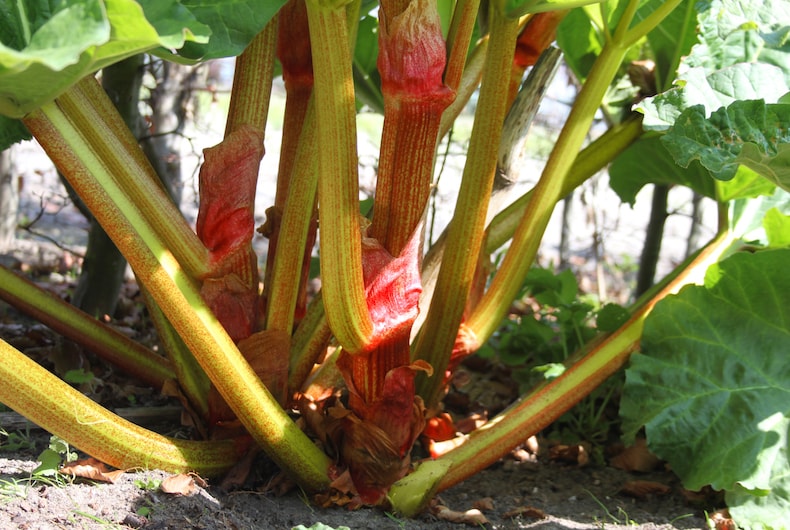
Growing your own veg from seed can help save money
Image: Rhubarb 'Timperley Early' from Thompson & Morgan
What could be better than rounding off your Sunday lunch with a piping hot bowl of rhubarb crumble? Or how about a delicious rhubarb pie, summer fool or homemade jam? Rhubarb is an undemanding perennial that’s easy to grow and fantastically hardy. In fact, it actually needs a cold snap in order to produce the best crops.
A healthy rhubarb plant will remain productive for at least 10 years so it makes an excellent investment. During the first year, you’ll need to resist the temptation to harvest the stems. But from the second year, you can harvest your rhubarb from April to June. Here are some tips on when to plant rhubarb and how to grow your own..
Which variety to choose
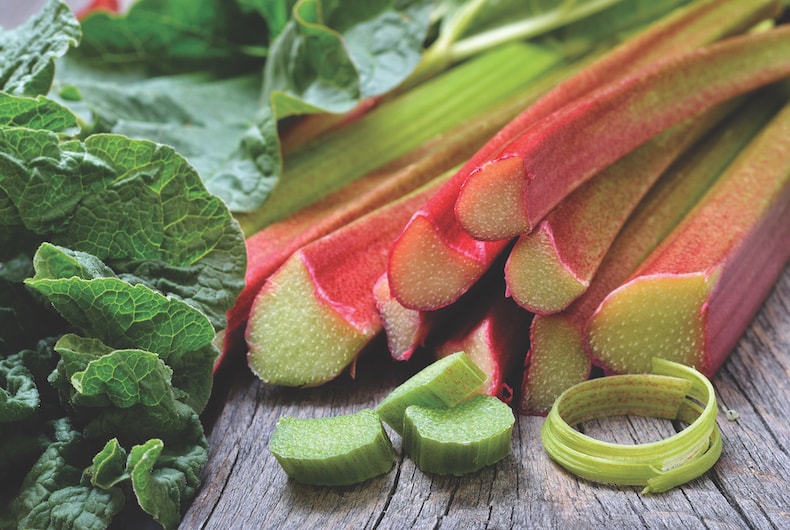
Different varieties have different flavours, strengths, and qualities
Image: Thompson & Morgan
There are lots of different varieties of rhubarb to choose from. Here are some of our favourites – all of which are suitable for planting in autumn or spring.
- 'Champagne': Reliable and easy to grow, this early variety is ideal for forcing to produce long, slender, pink-tinged stalks. Leave it unforced for a deeper, red-coloured stem.
- 'Victoria': These greenish-pink stems have an excellent balance of sweetness and acidity. Once established, it will produce a heavy crop, year after year.
- 'Raspberry Red': These have thick, deep red stalks with a superb sweet flavour that can be harvested early in the season, without the need for forcing.
- ‘Thomson’s Terrifically Tasty’: These thick pink, flavoursome stalks (that taper to green) are produced from March through to mid-summer, a whole month earlier than other rhubarb plants!
- ‘Fulton’s Strawberry Surprise’: These strong, vigorous plants produce eye-catching, vivid red stems with a well balanced acidity. It was voted best-flavoured rhubarb in the RHS Wisley trials.
- ‘Glaskin’s Perpetual’: This easy to grow garden variety produces large, juicy stems that can be lightly harvested the following year, if started in heat during the winter.
Should you grow rhubarb from seed?
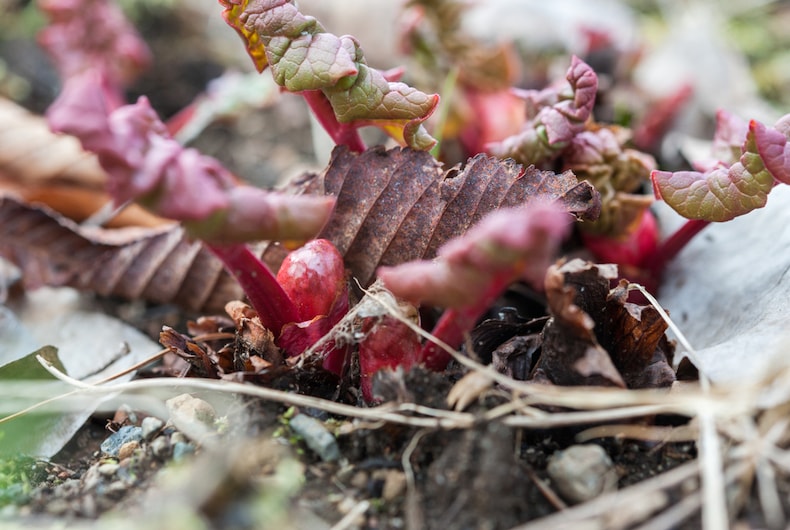
A rhubarb crown is a good option for beginners and green thumbs alike
Image: Shutterstock
Like most crops, you can grow rhubarb from seed, but it’s much easier to plant crowns or budded pieces. They establish well, making them ideal for beginners, but even experienced gardeners will appreciate the grow boost.
Rhubarb crowns are established plants that are at least one year old. They will produce a crop in the first harvest season after planting, which is much sooner than rhubarb plants that are grown from seed. Budded pieces, meanwhile, are a portion of an established crown. These can be cropped two years after planting.
When to plant rhubarb
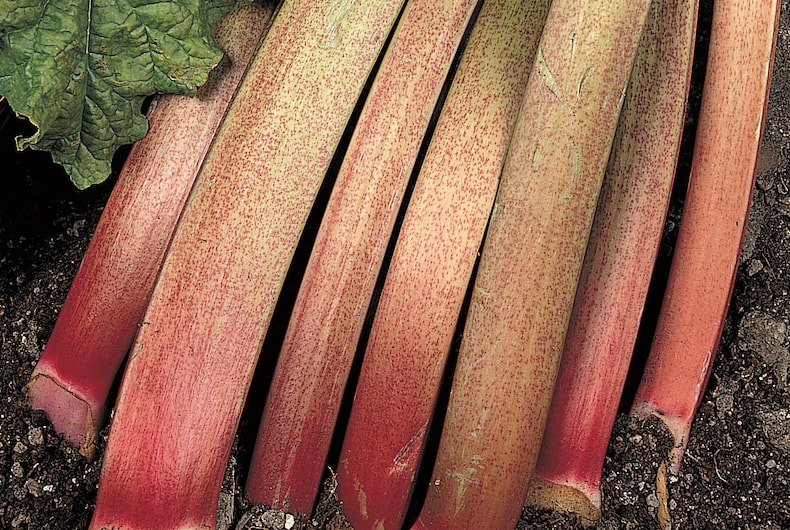
Rhubarb crowns are best planted in autumn or spring
Image: Thompson & Morgan
Rhubarb crowns and budded pieces are best planted in autumn or spring, while the soil is warm and moist.
If you’ve grown your rhubarb in a pot, this can be planted out at any time of the year as long as the soil is not frozen, waterlogged or suffering from drought.
Where should you grow rhubarb?
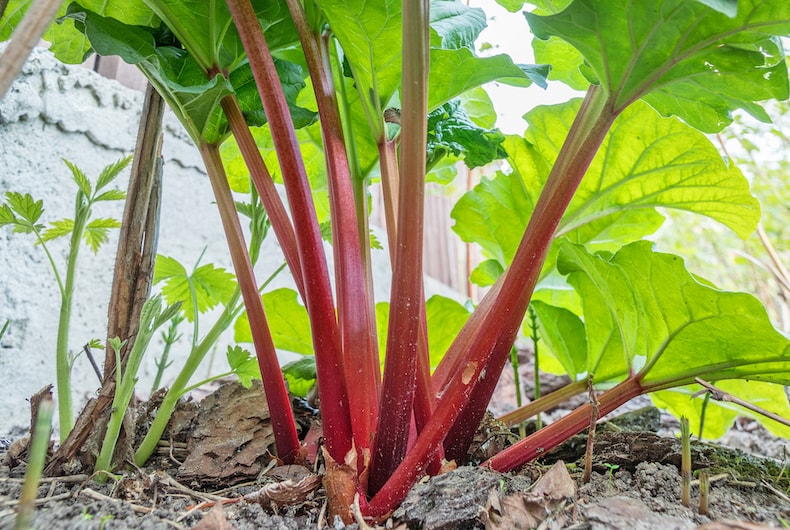
Find a place you're happy for rhubarb to grow for up to 10 years
Image: Rhubarb 'Polish Raspberry' from Thompson & Morgan
While undemanding, there are a few key things to keep in mind when selecting a place to plant rhubarb.
Firstly, rhubarb grows well in a sunny position with moist, well-drained soil, but it will tolerate semi-shade.
It doesn’t respond well to disturbance so the place you choose will need to be a permanent home – somewhere your plants can grow without interruption, from year to year. Take the time to properly prepare the right spot in your garden before you begin planting.
How do you plant rhubarb?
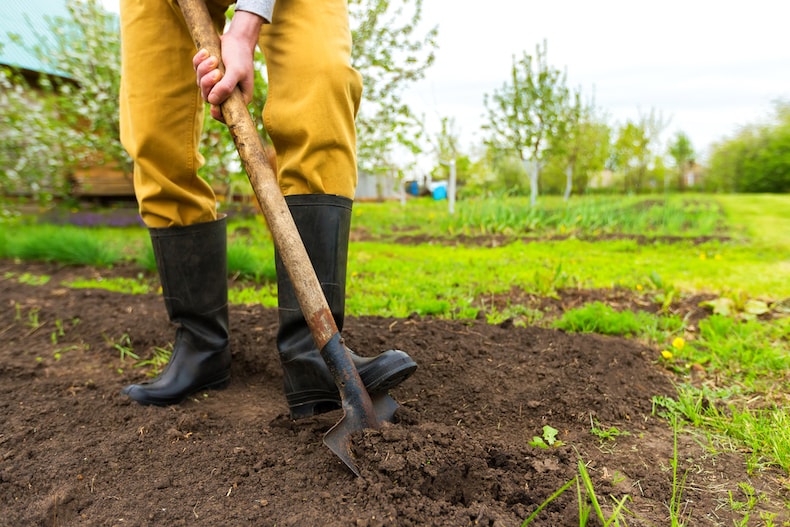
Take some time to properly prepare the area before you plant
Image: Shutterstock
Prepare the ground by thoroughly weeding the area and digging in two bucketfuls per square metre/yard of well-rotted manure.
Once you’ve done that, spread out the roots and plant so the tip of the crown is just visible above the soil.
When planting rhubarb crowns or budded pieces, set them so that the top of the crown sits 3cm (1") below soil level. If you’re gardening on a heavy, wet soil then plant them slightly higher, so that the top of the crown sits at ground level. This will help to prevent crown rot. Rhubarb plants can get quite large so allow a spacing of 75cm (30") between them.
Can you grow rhubarb in a container?
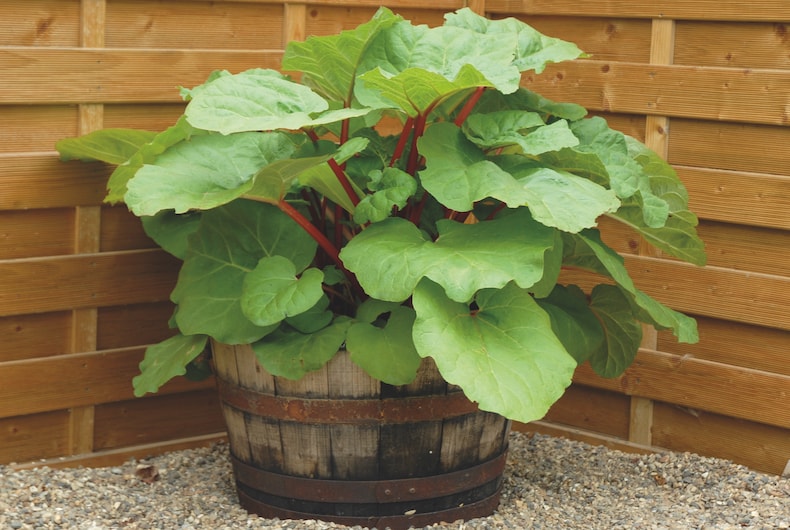
A big, deep container is a good option for growing rhubarb
Image: Rhubarb 'Fulton's Strawberry Surprise' from Thompson & Morgan
Rhubarb plants have big root systems so they do require a decent amount of space to grow. But if you use a container that holds a minimum of 40 litres of compost, you should be fine. In fact, you’ll most likely produce a decent crop.
A soil-based compost, such as John Innes No 3. mixed with plenty of well-rotted manure, is best for growing rhubarb in a container.
How do you force rhubarb?
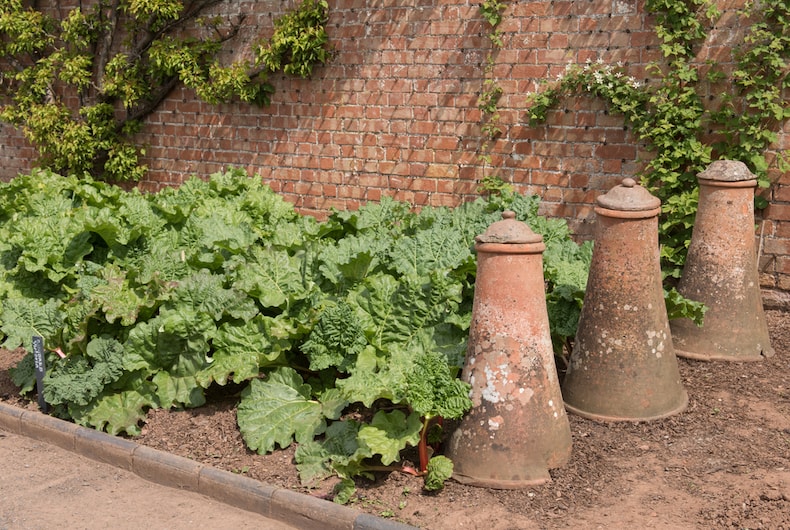
Traditional forcing pots work, but so do dustbins and buckets
Image: Shutterstock
Forcing rhubarb will yield an earlier crop – a useful option if you can’t wait until April for your first harvest. While clay or terracotta pots are traditional (and are specifically designed for this purpose), an upturned dustbin or a large bucket will work equally well.
In January, cover the crown with a layer of straw and then place your choice of large container over the crown to exclude the light. Forced rhubarb stems can be harvested around eight weeks after covering, which may be up to a month earlier than unforced crops.
However, try to avoid forcing the same rhubarb crown for two years in a row; this can weaken the plant. Our top tip? Grow several rhubarb plants at a time and force just one a year in rotation.
Any seasonal advice for growing rhubarb?
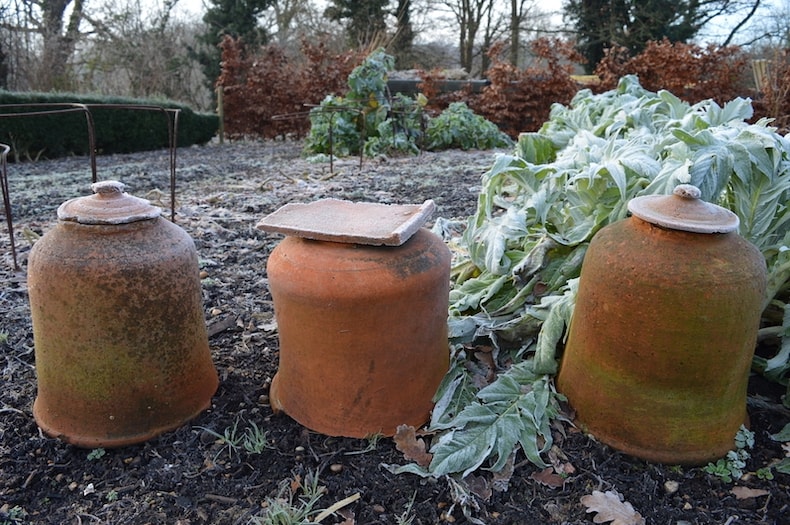
Rhubarb needs different things at different times of year
Image: Shutterstock
Rhubarb plants are very low maintenance, but they will produce better crops if given a little extra care and attention according to the season.
- Spring: Remove rhubarb flowers as they appear in order to direct the plants’ energy into growing tasty stems. A feed of general purpose fertiliser will also give them boost during this time.
- Summer: Keep an eye on your rhubarb plants and water them during dry periods. You don’t want the soil to completely dry out. Rhubarb that’s grown in containers will need to be watered much more often in order to keep the compost moist.
- Autumn: When the leaves die back naturally, simply cut back the old rhubarb stalks to leave the buds exposed. Apply a mulch of well-rotted manure around the crown of the plant; this will help to conserve moisture in the soil and keep the weeds down, as well as feeding the plants for the following growing season. But take care not to cover the crown as this may cause it to rot.
- Winter: Every five or six years you’ll need to lift and divide the rhubarb crowns in order to maintain their vigour and ensure that the plants remain productive. Use a spade to lift each crown before splitting it into 3 or 4 pieces and replanting them separately. Each piece needs a healthy looking bud – this will become the growth point for next year's new shoots.
How do you harvest rhubarb?
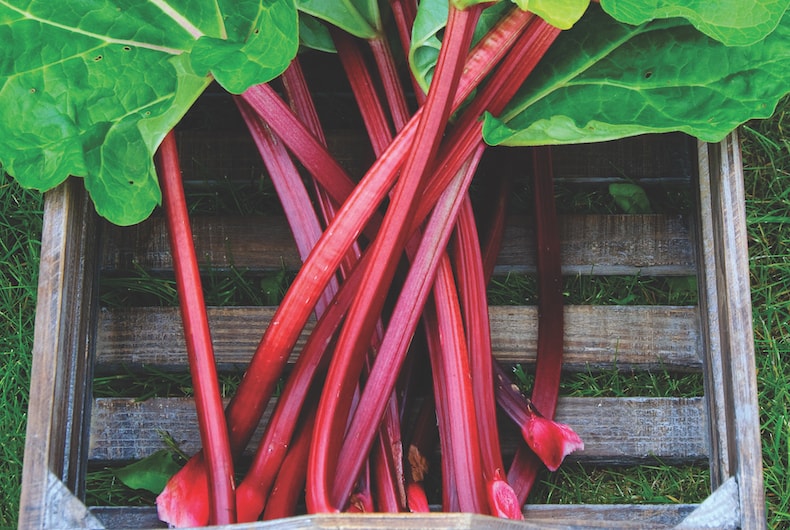
Rhubarb needs different things at different times of year
Image: Rhubarb 'Raspberry Red' from Thompson & Morgan
During the first year, you need to resist the temptation to harvest the stems, in order to allow your rhubarb plants to become properly established. But your patience will pay off because, from the second year onwards, your rhubarb can be harvested from April to June, when the leaves have fully unfurled and the stems are 30cm long.
To harvest, pull each rhubarb stalk from the base of the stem and twist it away from the crown. It's important to only harvest a few stems at a time (never more than half of the available stems), as over-cropping will reduce the plant’s vigour.
The rhubarb plant will need time to build up energy reserves for next year’s crop, so make sure to finish harvesting by the end of July. Don't worry if you find that you have more rhubarb than you can use; rhubarb freezes really well. Pickling and preserving is also a great way to extend the shelflife of your rhubarb.
A word of warning: only the stems of rhubarb are edible. The leaves contain oxalic acid, which is toxic if eaten. Simply trim the leaves away from the stems and add them to your compost heap.
Any problems to watch out for?
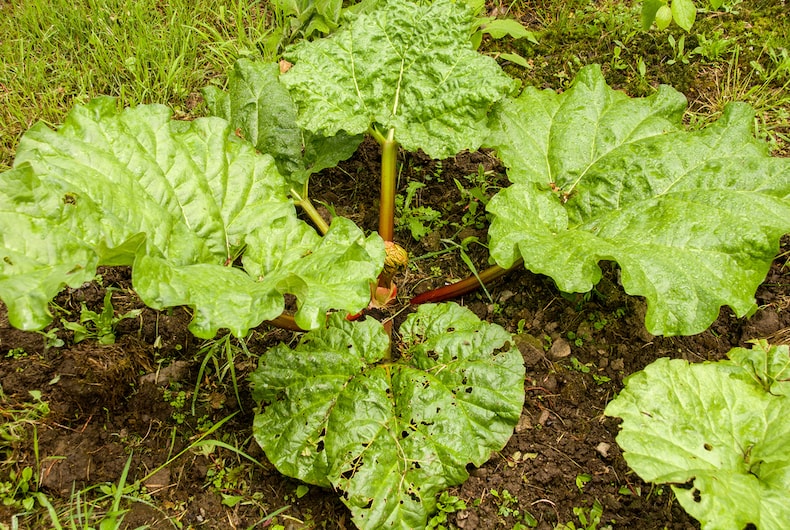
Slugs and other critters may find your rhubarb appealing
Image: Shutterstock
Crown rot can be a problem when growing rhubarb. It’s caused by fungi or bacteria (either in the soil or water) and, once it spreads, the disease call kill the plant. The best thing to do is act quickly and cut away any affected areas of the plant. Don’t be afraid to cut into healthy plant tissue – it could save the whole plant.
You may find that slugs, snails and other garden critters feed on your tasty rhubarb. The bane of gardeners all over the world, you’ll probably have your own way of dealing with slugs, from eggshell barriers to biocontrols. Keep an eye on your plants and deal with any pests quickly.
Which slug-deterrents have worked best for you? Get in touch over on our Facebook page and let us know! In the meantime, happy growing! Looking for tips on how to force rhubarb for early harvests, or recipe ideas on how to use up your glut? Visit our dedicated rhubarb hub page.
Return to
Other quick links
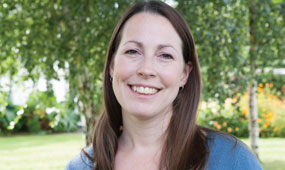
Written by: Sue Sanderson
Plants and gardens have always been a big part of my life. I can remember helping my Dad to prick out seedlings, even before I could see over the top of the potting bench. As an adult, I trained at Writtle College where I received my degree, BSc. (Hons) Horticulture. After working in a specialist plantsman's nursery, and later, as a consulting arboriculturalist, I joined Thompson & Morgan in 2008. Initially looking after the grounds and coordinating the plant trials, I now support the web team offering horticultural advice online.Sign Up For Exclusive Special Offers




© 2024 Thompson & Morgan. All rights reserved. A division of Branded Garden Products Limited.
Sign up for exclusive offers!



